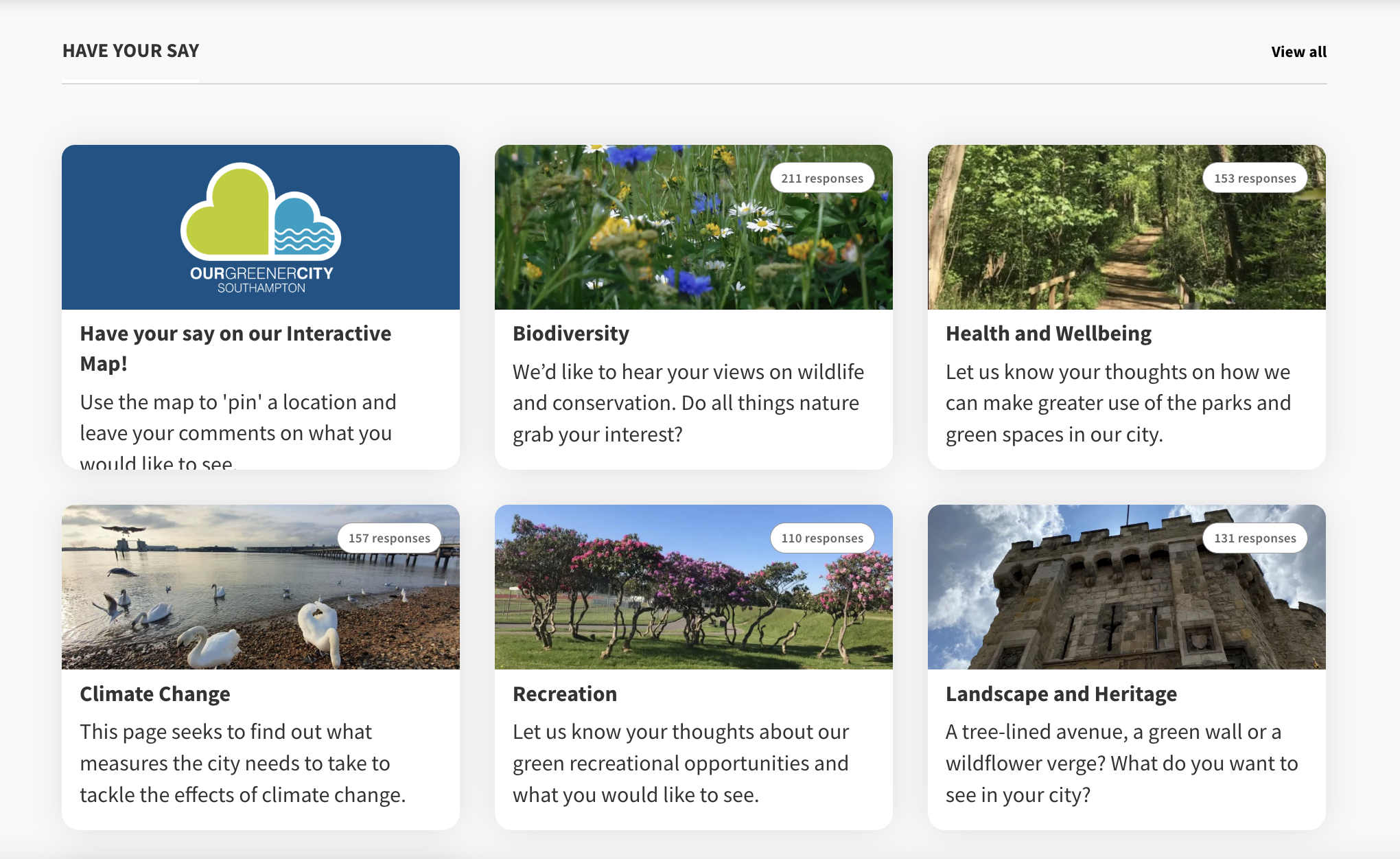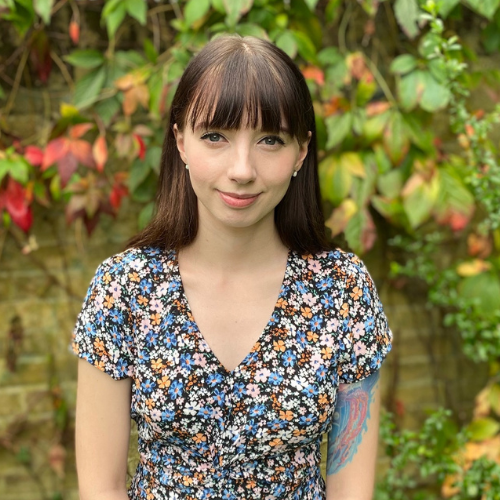In honour of the long bank holiday weekend, take a look at our top five green space projects and the work that’s been done to improve local nature spots.
A long weekend is the perfect time to get some fresh air, especially when there’s rare good British weather to enjoy. From picnics, to walks, to visiting blooming gardens and nature spots, having access to well-maintained green spaces is something that can greatly affect the overall feel of an area as well as the quality of every day life for those that live, work, visit and play there. Given the bank holiday weekend and the amount of people (including many of us) who are taking this time to enjoy our local green spaces, we’ve gathered some of our favourite nature projects for you to enjoy.
Are you looking to engage local people to improve your local parks or gardens? See how Commonplace can help you with a personalised consultation. Just click below to book a free demo.
1. Southampton City Council: Our Greener City

Southampton City Council has been capturing information about the local parks and green spaces so they can create a ‘green grid.’ These grids are a patchwork of natural areas that have a number of benefits, including: improving air quality, enhancing biodiversity as well as encouraging more active travel. By collecting the thoughts and ideas from the local community, the council is currently forming an action plan to help design a ‘green grid map’ and make improvements to existing parks and spaces.
The engagement came in the form of an interactive Commonplace Heatmap, where anyone could drop a pin and leave a comment on what they’d like to see added or improved in the area. All comments are visible to anyone visiting the Heatmap so a general consensus can easily be seen and actions drawn from those suggestions.
The Commonplace website also includes surveys on specific topics such as Health and Wellbeing, Climate Change and Recreation. Each of the questions has been carefully crafted to get the most usable information from each answer. The whole project has proven extremely popular with both the map and surveys gathering almost 3,600 contributions since its launch in 2020. The feedback has shown just how important gardens are in the city in terms of greenspace as well as raising specific issues such as need for gaps in fences to allow wildlife (hedgehogs and amphibians), to move around and to forage.
2. Camden Green Space Community Hub

This website is a hub for all of Camden Council’s past and ongoing green consultations. These consultations are part of the Green Space Investment Programme (GSIP), a capital investment for local parks and green spaces so they best meet the needs of local people. It will also support the ambitions of ‘Camden 2025’- a community plan to improve the borough built on ideas submitted by the citizens themselves.
Camden’s Green Space team manages 74 parks and over 300 further green spaces as well as over 38,000 trees. For the past two years they’ve been using Commonplace to engage with local communities and collect their views on green space projects and policies to make sure their work is effective as well as public-focussed.
Their website has multiple tiles, each representing a different active engagement across Camden, covering everything from a new biodiversity action plan to gathering suggestions on how best to improve existing open spaces.
3. Flow Country Proposals

The Flow Country, a vast expanse of peatland in Caithness and Sutherland in the Scottish Highlands, has been nominated for UNESCO World Heritage status and Commonplace is there, gathering community input to help make that happen!
The area is made of deep peat, dotted with bog pools and covers about 200,000 hectares. The blanket bog itself is more than twice the size of Orkney and an important habitat for many rare species of animals and plants. Using a community Heatmap, the team (including the Highland Council, Nature Scot and RSPB Scotland) are gathering comments on the proposed site boundary - a key element of the Flow Country World Heritage Project. By leaving comments, the local population can easily highlight any sections they have concerns over, or areas they would like to see included as part of the heritage site. The questions in the community surveys gather data on what the most important benefit of World Heritage Status is to local people, for example increased tourism or more environment funding.
The public engagement is currently entering their last few days of in person consultation but will continue online until the next phase of the consultation period in July, with all information clearly displayed in the news segment so no one misses out on crucial updates on the project.
4. Shoreditch Park improvement project

Let’s look at a specific park improvement project. In 2019, £2 million was provided for a community-led improvement scheme in Shoreditch Park. Planning approval was granted in June 2021 and, whilst improvements to the Park were postponed due to the pandemic, work to build new play and sports facilities began in March 2022 and has been ongoing since.
To make sure that the local community was as much a part of this project as possible, Hackney Council used Commonplace to run a public engagement and gather views about what people loved about the area as well as what improvements were needed. As it was already such a popular park, the project ended up with over 1,900 local people and park users taking part. They provided ideas to shape the designs and commented on the proposals which included new benches and bins; more trees, as well as the sports hub and play area that are currently under construction.
While the engagement portion of the project is over, all comments and news are still available for public viewing so the provenance of the changes is easily accessible and transparent.
5. #ParkPower

One thing the pandemic highlighted decisively is the importance of access to parks and other green spaces. The LDN Collective set out to see exactly why this was the case, gathering the views of Londoners about the capital’s most popular parks.
COVID-19 has focused us all on the value of communities and the role of green spaces. Both have been transformed from ‘nice-to-have’ into critical resources. - Max Farell, Founder and CEO LDN Collective.
During the summer of 2020, the LDN Collective crowdsourced opinions from Londoners about their parks, asking the locals what they valued most about them and what they would prioritise in the future. Having gathered over 3,500 responses from people living in every single London borough, they have built up an extraordinary picture that illustrates the critical importance of regular access to nature and green spaces.
Using both a Commonplace interactive Heatmap and a number of traditional surveys, they wanted citizens to participate by thinking constructively about their lived experience in local green spaces and how this relates to what they would want to get out of them in the future. Commonplace helped craft both open and closed questions for the surveys to get the most usable data and to help people really think about how London’s parks affected their day to day lives.
The meaningful number and vast spread of responses gave the LDN Collective enough information to create a free-to-download eBook where you can see the main themes of answers that were provided over the course of the crowdsourcing. CEO and Co-Founder, Max Farell, also talked about the findings of the project in our recent webinar “Global Engagement and the Power of Partnerships”. You can watch the recording for free.
Check out the #ParkPower Project
Looking to improve local green spaces and want to make sure it’s a public-led project? As you can see, we can definitely help with that. Just click the link below to book a free demo where our team will be more than happy to come up with a personalised plan for your project.
.png)


